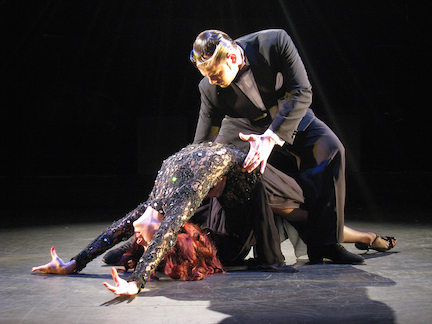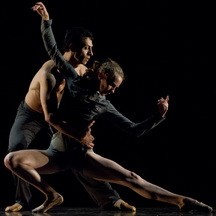
There is a famous tango scene in the film The Four Horsemen of the Apocalypse (1921) in which Rudolph Valentino slinks around the floor with Beatrice Dominguez. He does a sultry job of it, despite the gaucho boots and long spurs, enough to make any dancer stumble.
It’s hard to know if the heartthrob of silent films was instrumental in making this dance, born in the lower-class neighborhoods of Buenos Aires and Montevideo, a world-wide dance craze, but there it is – a wildly popular dance far outside the boundaries of its South American birthplace. Even the Finns have their own brand and style of the tango, brought to the country in the 20s and remaining popular today.
Today, versions of the tango can be seen in everything from TV ballroom dance competitions to popular classes and night club dances, in a variety of forms. But perhaps one of the most stylish of these performances is Luis Bravo’s Forever Tango, which opened at the Herbst Theater in San Francisco just before Christmas.
Comprised of 12 dancers in a series of exquisitely choreographed and executed tangos, Forever Tango claims to present a historical version of the history of the tango. This is only a bit true, and its brief nod to the dance’s history is really of small relevance to the complex and satisfying spectacle presented on stage.
The production presents the historical part early on, with a glamourized version of the bordello life identified with the dance born in the 1890s along the River Plate between Argentina and Uruguay. Decorative though the portrait may be it does set the tone of the tango we will see. The men are big and the women lush. The dance seductive.
The tango is an intricate partner dance, with footwork that requires split-second timing on the part of both dancers. Forget when you are supposed to be kicking and pivoting and the less attentive might land on the floor in a tangle of arms and legs.
It is not the footwork, however, that defines the tango presented by these dozen dancers. Or what is traditionally thought of as the tango, and was captured in that tango that Valentino filmed almost 100 years ago.
Rather, it is the attitude between the dancers that defines the dance. Here we have dance as an enactment of sexual struggle. The man is the pursuer and the dance the pursuit. He is both the adorer and the dominator of the woman he leads across the floor. Throughout the women remain distant; their faces impassive. They provoke and follow even as they reject. And reject they must, or they would find themselves slaves to their men’s desires.
As is often the case now in professional ballroom dancing, many of the dancers have classical ballet training. It was interesting to see that the aloofness often identifiable with ballet finds itself in harmony with the projected attitudes of the tangoistas. Even so, there is an earthiness missing in those ballet dancers that is essential to capturing the spirit of tango.
This sensuality was captured most fervently by Diego Ortega and his partner, the long-haired Aldana Silveyra. Sebastián Ripoll and Mariana Bojanich added elegance to the restraint to their sensuality. Ariel Almiron and Natalia Turelli added comic exuberance to the mix.
One of the delights of Forever Tango is the live music. What fabulous musicians! Led by the bandeoneón player, Horacio Romo, the 10-member band danced us through a lively selection of the old and the new. Even “La Cumparsita” was there, reaching back to our earliest memories of the tango. Violinist Humberto Ridolfi was the soloist in the formidable “Jealousy.” Pianist Jorge Vernieri channeled Rachmaninoff in his solos. And everyone was channeling Astor Piazzolla. Marcela Ríos, a 1930s style Argentine vocalist, with a voice low enough to vibrate the strings of the double bass, brought the lovers’ lament into haunting Spanish.
– Jaime Robles
Forever Tango continues at Herbst Theater until January 10. Information and tickets can be found at www.forevertango.com or 415-392-4100.
Photo: David Leguizamón and Belén Barolomé.
